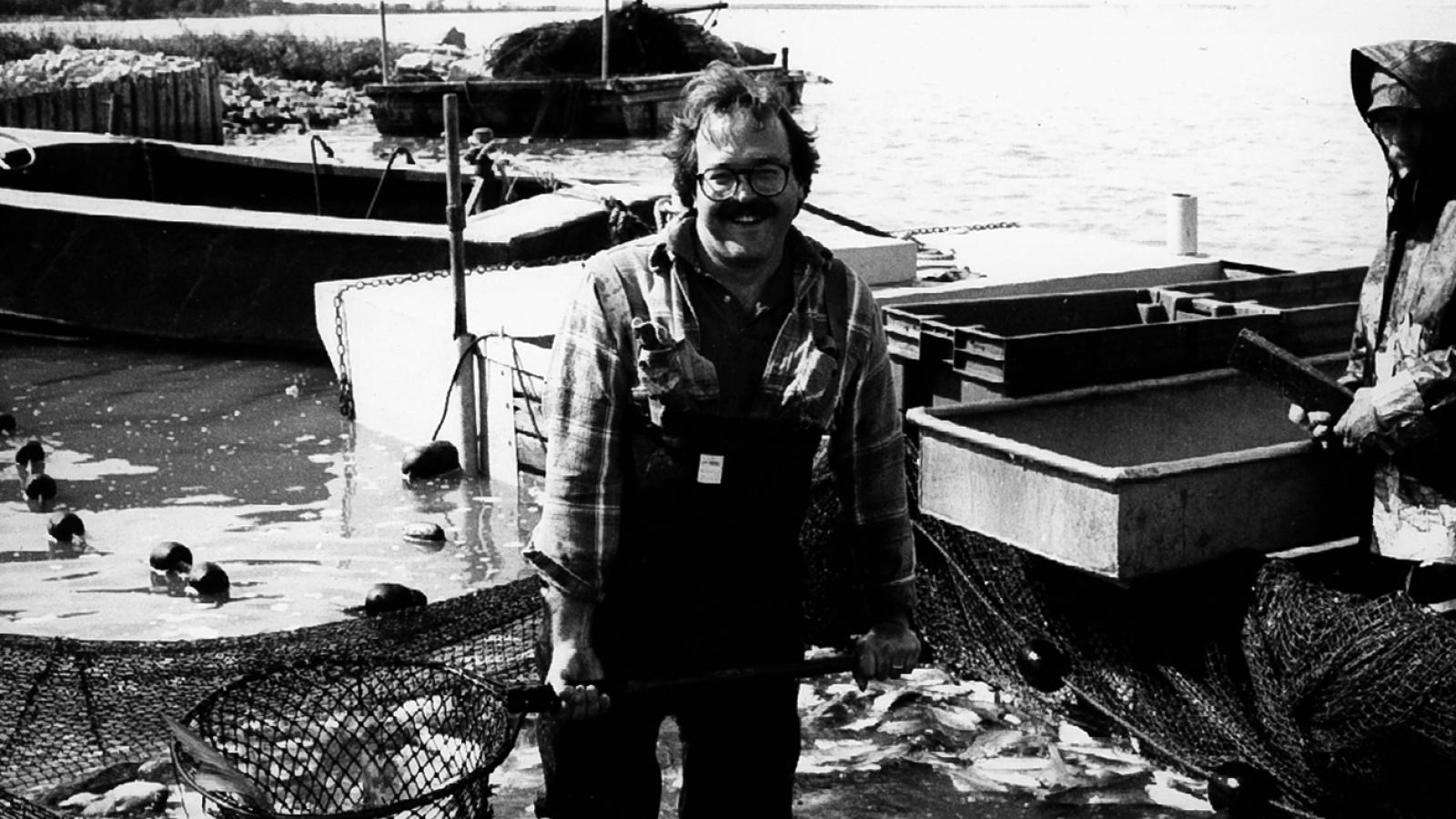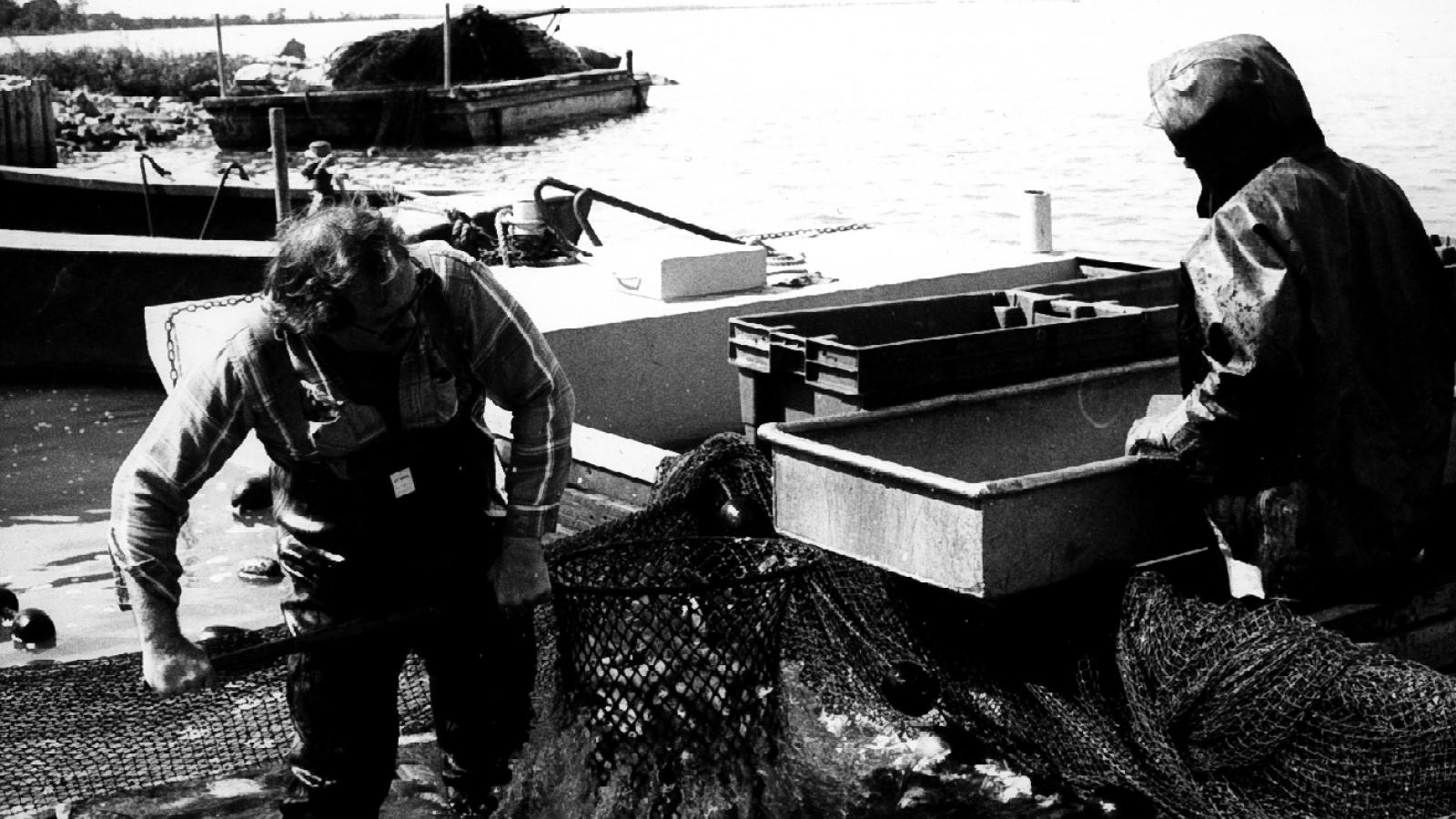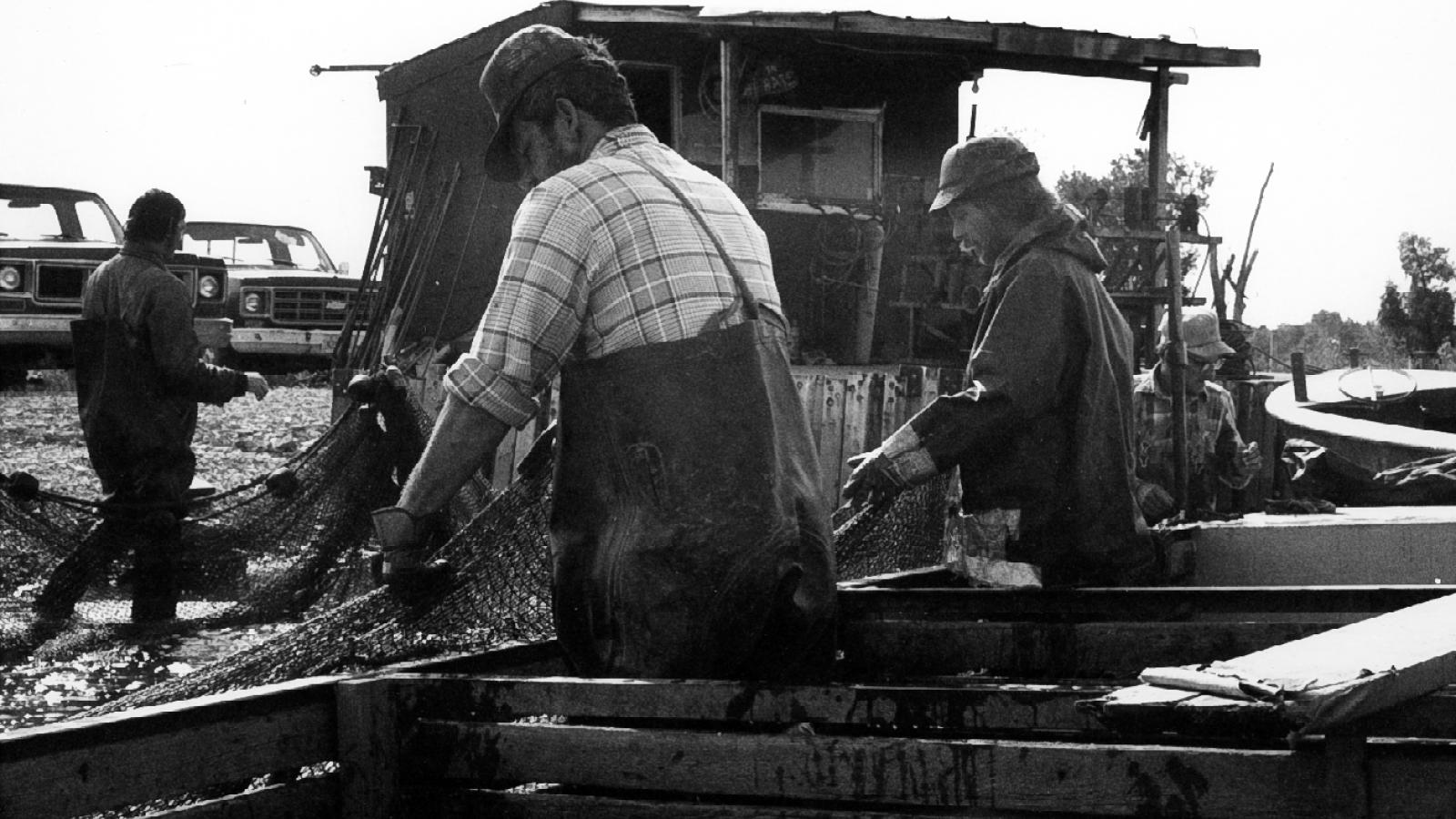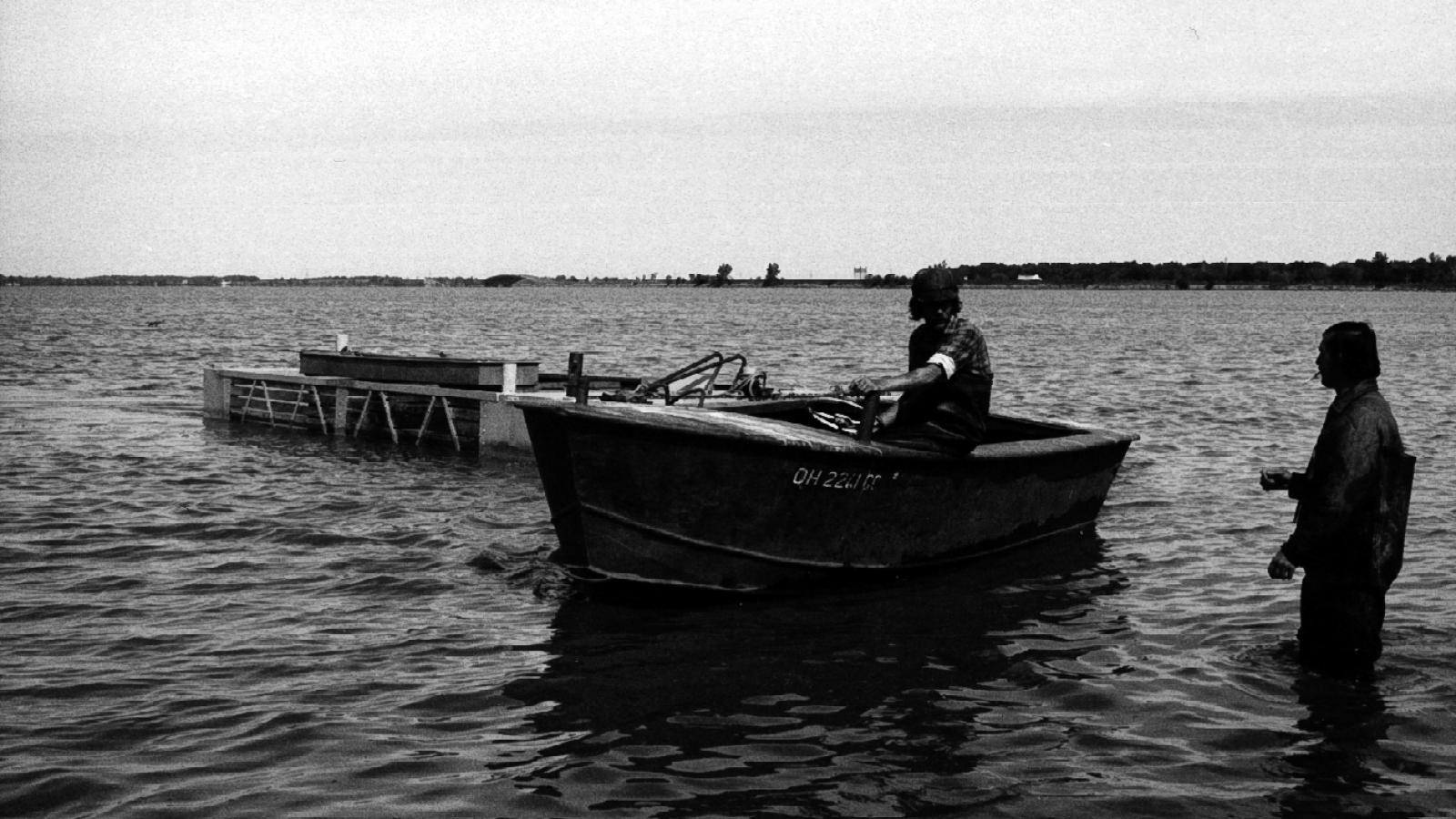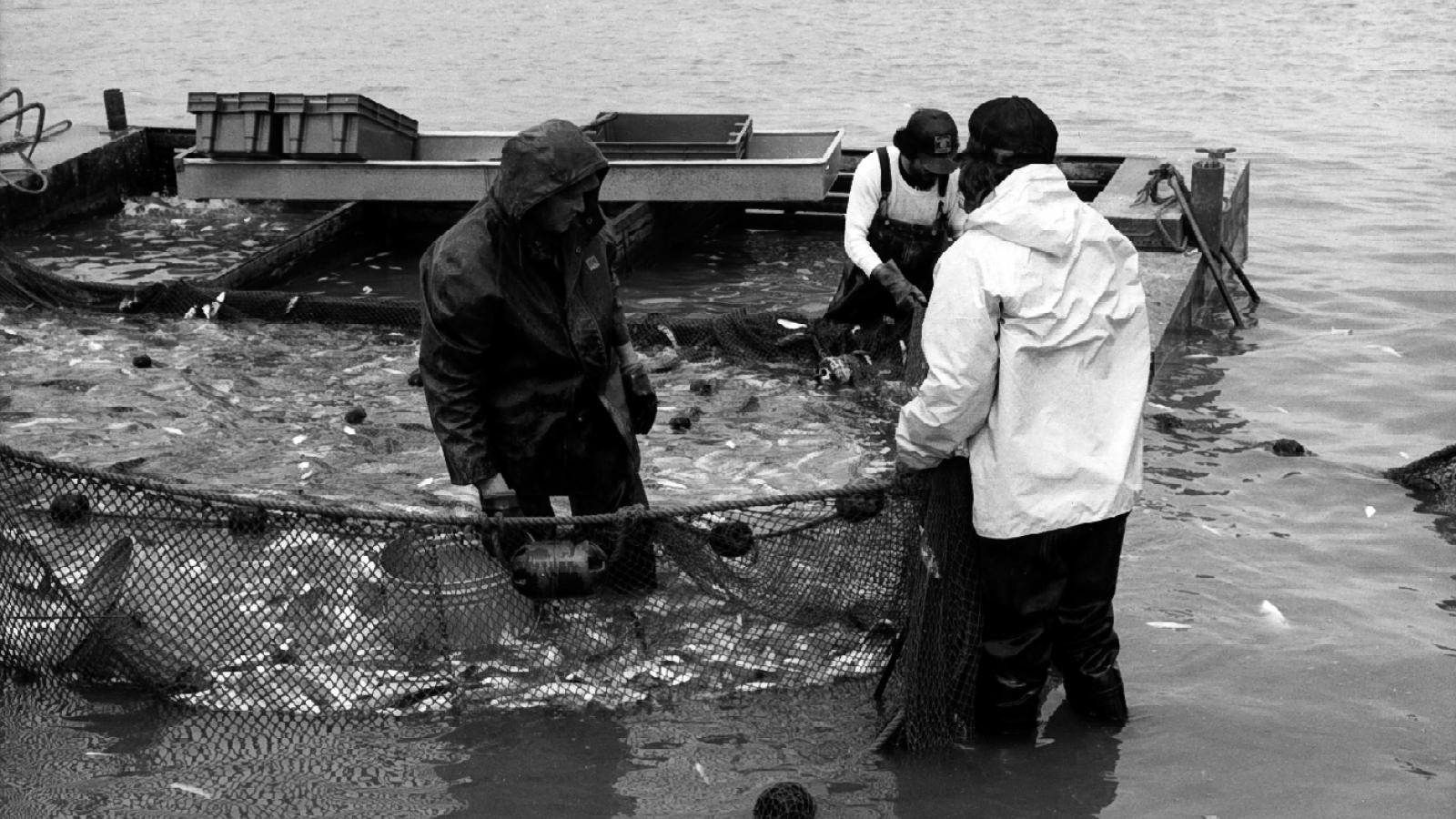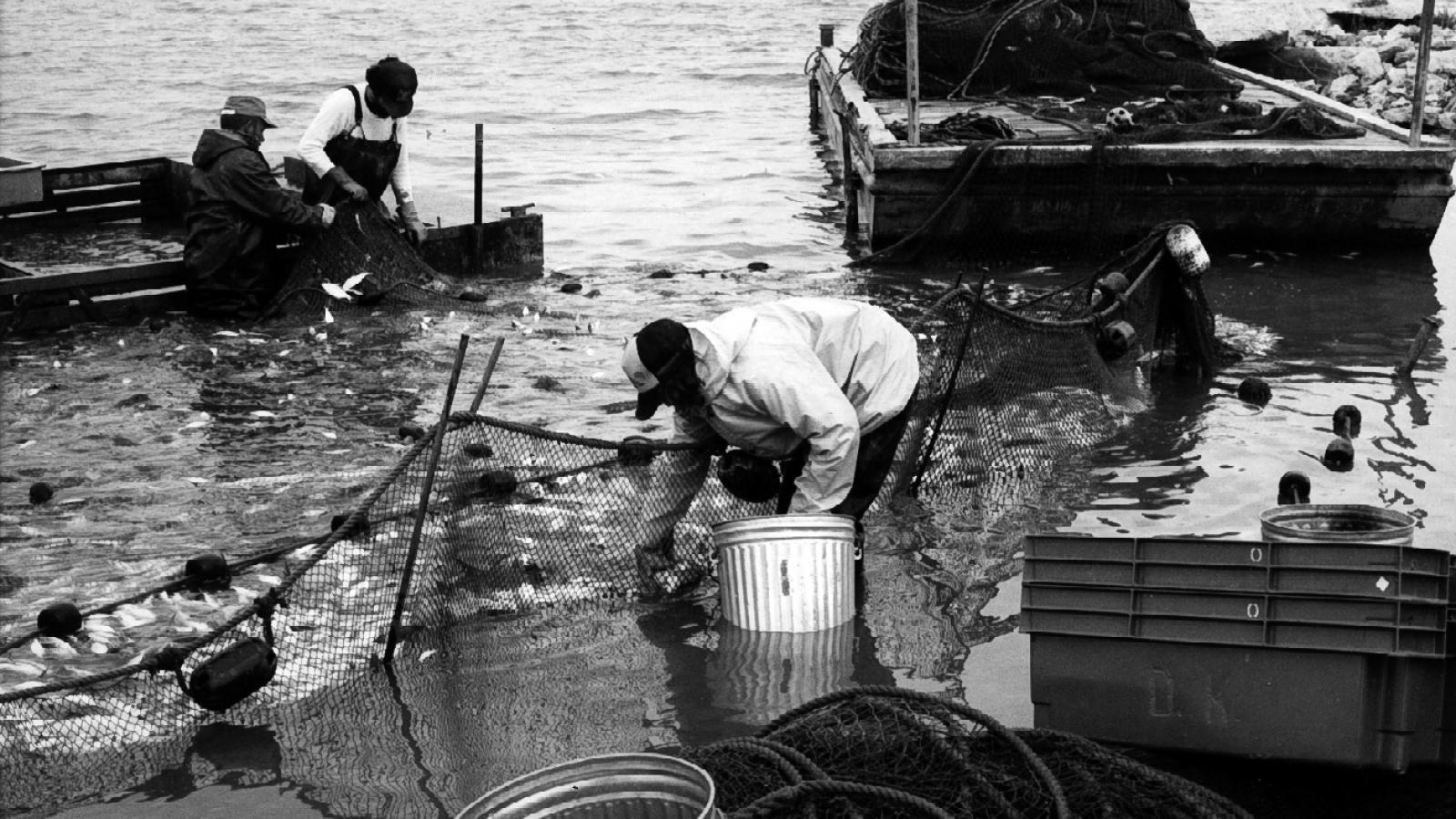Seining is not done with a boat, but rather off the shore of the lake or of the shallow Sandusky Bay towards the lake's western end. A seine net (usually a half mile in length and ten feet high with a quarter mile line at each end) is towed out in a large circle from the shore seining site by a small boat or skiff. The net contains a large pouch or "pocket" at its center. The ends of the line, stretched out away from the site by poles, are drawn into shore by a powered winch, and the circle of line and net are pulled into shore over a three-or four-hour period, gradually drawing the captured fish into the pocket. When only the pocket remains in the water, its edges are lifted above water and staked in place and the crew members, who have moved a half-submerged skiff next to the pocket, pass fish into the skiff with a hand net or by hand where, still in the water, they are sorted and loaded into trucks.
Interview Transcript Excerpt: 84-01 CT 01
Seining: 83-01 PhN 02-14
PM: Well, how much luck is involved in fishing, and how much is knowing when and where to fish?
LG: Well, seine fishing, you only fish one place. Oxygen is out there. Different winds blow, and make the fishing a lot better, and the luck of it is if you can sell the fish and get a price for them.
Seining: 83-01 PhN 02-17
PM: It's all important. How many seining operations were there on Sandusky Bay during the peak time when you were fishing?
LG: I can tell in a minute if you want to wait a minute,
PM: Sure. And the names. Do you remember?
LG: Bob Swartz, he fished at Dew Drop…He might have fished at, in the bay off of Port Clinton. The next would be me… And Turinsky fished just beyond the point. And Kenny Hall fished at, over west of Danberry, and Turinsky fished east, and Tom Spencer was along Johnson's Island, and most or all was dead fish operations. Except myself, I brought in live fish whenever I could. Kept us alive for quite awhile. You know when you have a live fish, you gotta have gloves on, and like 10 or 15 in a tub with 5 or 6 inches of water. Put it right in the tub with water and carry them up and put them in the truck. And be sure you don't lose them fish. And once or twice we loaded them barehanded, you know, and the drivers come, and they were really mad about it cause all them fish had our fingerprints in them. We learned by ourselves what to do, how to handle them.
PM: How many men would be in a crew working the seines?
LG: Four or five of us.
Wife: Usually five. Years ago, I was one, too, I used to help him pull nets. I quit.
PM: That was pretty hard work, wasn't it?
Wife: No. Not any harder than any other work.
PM: Sounds like it was pretty unusual to have a woman as part of the crew.
Wife: The wives all helped.
PM: Did you have any trouble with bad weather when you were seining after you started in the business?
LG: Oh, yes. You get stuck and the wind picks up, why, you gotta finish the job. It may take a lot of water. I've had my waders so full I couldn't walk with them. I had to crawl. After the waders are full, that's a pretty good batch of water, you know.
PM: When you were out running clean up seine and hauling in, did the different people that were on the crew have different jobs to do when they were doing that?
LG: Well, everybody just helped get it back in. There would be one guy or two. One would run the boat and one ride the scow. When they'd get back in, everybody was supposed to do their share. We always paid by percentage. If I made any money, the men made money. I remember one year back when the war started, I remember the boy, we fished three weeks. The boy made a check of $35.00 apiece. The next three weeks they made $3,000. Anyhow, that was the sheephead were no good. Then the price sf sheephead went up to 7¢ Ib. Maybe the war maybe helped that out, I don't know. Anyhow, for a couple weeks, we made pretty good money.
TL: How much does a license cost for y'all?
DK: My seine license for this one net costs me $600.00 per year.
TL: What did it cost when you were starting out? You started out you say in the late 60’s, about 15 years ago.
DK: I started in the middle 60's with trout line, just like my own kid does. But we paid $4.00 per rod per net. If we had 100 rod seine, it was $40.00; if we had 200 rod seine, it was $80.00. If we had a 300 rod seine, it was $120.00. Trap nets was $4.00 a net. Set 10, 12 trap nets, it cost you $40.00. Set 20 trap nets, it cost you $80.00. Trap nets went up to $800.00 for 20 nets. I mean that's fairly reasonable yet. I mean I'm not disputing the price for license. I agree that our licensing system was too low. I think it's much more in line right now considering that we have to pay royalty fees on our higher valued species of fish, too, so that adds to the cost of our license. I don't agree with the royalty fee system though. I think that's stupid. I think you have to pay royalty fees in the state of Ohio over half of what you caught the previous year per species. White bass, catfish, yellow perch, and walleyes. Which means if you caught 1,000 pounds last year, and you catch 2,000 pounds this year, you're gonna have to pay on 1,500 pounds.
PM: You say all your kids helped out from time to time? When they got old enough to help?
Emma: Why, I went and got our boys from school when they was like this, and we'd help pull seine in. Paid them for it. Always paid them.
PM: Was that a problem to get them out of school?
Emma: After school. I never took them out of school to fish, no. They got their education first. That was something. After school hours they would come down and help pull seine in or on days they didn't have school, they would help.
PM: I get that sense still that all the fishermen seem to know each other. Like you mention Larry Davis, Turensky, and they know you.
LK: Hell, I know a lot of fishermen that's been around. Like some of my nephews, they are seine haulers along the bay here. I get to talk with them, and they're always pert near the same. They think nothing about fishing. But, they fish on shares, you know, and like this year, Jeez, this was the worst year they ever had.
PM: For the seine haulers?
LK: Yes, they didn't make no money at all. Christ, they just lost everything. Like Turensky's down there, they got a hell of a big outfit, and they didn't do nothing this year. Used to get a lot of white bass, see just go up the bay and spawn and that. Christ, they used to have loaded trucks down there with live white bass. There was a lot of money in that those days. I seen a day when Iworked for them, helped them out down there. Hell, they'd load four or five trucks with those white bass live. Used to get 15 to 20 cents apiece for them, you know. You take them damn trucks, they'd haul about 1,500, and you take that kind of money, why, that was money. And catfish. Christ, they used to catch catfish by the tons here in the bay. That's when your snails and clams were still there. That was catfish food. Now the clams are gone, the snails are gene, the catfish are gone. Christ, you're lucky if you get, on a haul, you're lucky if you get 50 or 75 pounds. And, Jesus, you take that seine they got is 190 rod seine beside four coils of rope on each side, and they run that way out over halfway over the bay, and then they run the seine off, then they run the other four coils of rope in, see, the four coils on each side. Hell, you start that seine out at 6:00 in the morning. It's around 10 or 10:30 before you can get that seine into shore. That covers, hell, that covers a hell af a lot of territory. And, Jeez, for what fish they're getting, it's a lot of damn work.

